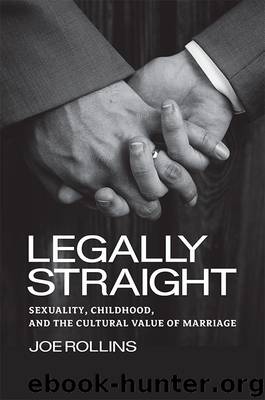Legally Straight: Sexuality, Childhood, and the Cultural Value of Marriage by Joe Rollins

Author:Joe Rollins
Language: eng
Format: epub
Tags: LAW000000 Law / General, Law, Family & Relationships, Marriage, Children, Administrative Law & Regulatory Practice, Family Law
Publisher: NYU Press
Published: 2017-12-26T00:00:00+00:00
Procreation at the Supreme Court
The procreation argument appears in both Windsor and Obergefell, but its rhetorical effects are rather different than we have seen in lower courts. In Windsor specifically, dissenting Justices Roberts and Scalia were primarily concerned with the majority’s theory of justiciability, that is, the Court’s willingness to have heard and decided the case in the first place, and their treatment of the procreation argument is brief. Yet, for the dissenting members of the Court, procreation is among the central defining features of marriage, and although it appears, it is less developed rhetorically than it was in lower court decisions. I will return to the other elements of their rhetorical strategies below, but for the moment I focus on Justice Alito’s treatment of the procreation argument.
Justice Alito’s dissent in Windsor shares the same primary concerns that animate the dissents of Justices Roberts and Scalia: justiciability. All three justices argue that the Court should not have heard the case in the first place because although Edith Windsor had not yet been given a refund for her overpayment of taxes, she and the executive branch agreed that she was entitled to receive one. According to Justice Alito, Edith Windsor was not merely challenging DOMA or seeking a refund on her taxes; rather, “what she seeks is a holding that enshrines in the Constitution a particular understanding of marriage under which the sex of the partners makes no difference.”1 Moreover, in Justice Alito’s interpretation, lesbian and gay couples seeking a right to marry were not asking the state for access to a long-standing institution with a demonstrable history of change. Instead, adopting a position seen as early as Baehr, Justice Alito insisted that the plaintiffs were seeking a very new right.
Examining two “competing view of marriage” is a central feature of Justice Alito’s dissent.2 The “first and older” view he refers to as either the traditional or the conjugal view of marriage, defining it as an “intrinsically opposite-sex institution.”3 Citing from the respondent’s briefs, Justice Alito anchors this view of marriage to an ancient history: “Until a few decades ago, it was an accepted truth for almost everyone who ever lived, in any society in which marriage existed, that there could be marriage only between participants of different sex.” This view of marriage he justifies by turning to the procreation argument: “[M]arriage was created for the purpose of channeling heterosexual intercourse into a structure that supports child rearing.” The second view of marriage Justice Alito sketches he refers to as the “consent-based” view of marriage, one that is about emotional commitment and sexual attraction between spouses. Because neither view appears in the Constitution, Justice Alito, in agreement with the other dissenters, thinks the Court should have declined to hear the case. But his greatest ire appears in a footnote that seems to take issue with the very appearance of the question:
Download
This site does not store any files on its server. We only index and link to content provided by other sites. Please contact the content providers to delete copyright contents if any and email us, we'll remove relevant links or contents immediately.
Killers of the Flower Moon by David Grann(3756)
Machine Learning at Scale with H2O by Gregory Keys | David Whiting(3654)
Oathbringer (The Stormlight Archive, Book 3) by Brandon Sanderson(2652)
Will by Will Smith(2589)
Once Upon a Broken Heart by Stephanie Garber(2530)
Guns, Germs and Steel by Diamond Jared(2206)
Borders by unknow(2121)
It Starts With Us (It Ends with Us #2) by Colleen Hoover(2053)
The Room Where It Happened by John Bolton;(2034)
Friends, Lovers, and the Big Terrible Thing by Matthew Perry(2012)
The Color of Law by Richard Rothstein(1824)
HBR's 10 Must Reads 2022 by Harvard Business Review(1702)
The Strength In Our Scars by Bianca Sparacino(1701)
A Short History of War by Jeremy Black(1677)
Water Rights and the Environment in the United States by John Burch(1607)
Examples & Explanations: Administrative Law by William F. Funk & Richard H. Seamon(1555)
515945210 by Unknown(1524)
Pharmacy Practice and The Law by Richard Abood(1497)
That Every Man Be Armed by Stephen P. Halbrook(1481)
